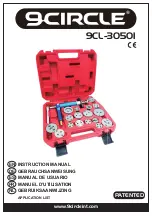
5
z
When servicing a tool, use only identical replacement parts. Use only authorized parts.
Use only the lubricants supplied with the tool or specified by the manufacturer.
z
Never connect to an air source that is capable of exceeding 200 PSI. Over pressurizing the
tool may cause bursting, abnormal operation, breakage of the tool, or serious injury. Use
only clean, dry, regulated compressed air at the rated pressure or within the rated pressure
range as marked on the tool. Always verify prior to using the tool that the air source has
been adjusted to the rated air pressure or within the rated air-pressure range.
z
Never use oxygen, carbon dioxide, combustible gases, or any bottled gas as an air
source for the tool. Such gases are capable of explosion and serious injury.
SPECIFIC SAFETY INSTRUCTIONS
z
The warnings and precautions discussed in this manual cannot cover all possible conditions
and situations that may occur. It must be understood by the operator that common sense
and caution are factors which cannot be built into this product, but must be supplied by the
operator.
z
Only use accessories rated to handle the forces exerted by this tool during operation. Other
accessories not designed for the forces generated may break and forcefully launch pieces.
z
Attach all accessories properly to the tool before connecting the air supply. A loose
accessory may detach or break during operation.
z
Obey the manual for the air compressor used to power this tool.
z
Install an in-line shutoff valve to allow immediate control over the air supply in an emergency,
even if a hose is ruptured.
z
Use this tool with both hands only. Using tools with only one hand can result in loss of
control.
z
Do not lay the tool down until it has come to a complete stop. Moving parts can grab the
surface and pull the tool out of your control.
VIBRATION PRECAUTIONS
This tool vibrates during use. Repeated or long-term exposure to vibration may cause
temporary or permanent physical injury, particularly to the hands, arms, and shoulders. To
reduce the risk of vibration-related injury:
1. Anyone using vibrating tools regularly or for an extended period of time should first be
examined by a doctor and then have regular medical check-ups to ensure medical problems
are not being caused or worsened from use. Pregnant women or people who have impaired
blood circulation to the hand, past hand injuries, nervous system disorders, diabetes, or
Raynaud’s Disease should not use this tool. If you feel any symptoms related to vibration
(such as tingling, numbness, and white or blue fingers), seek medical advice as soon as
possible.
2. Do not smoke during use. Nicotine reduces the blood supply to the hands and fingers,
increasing the risk of vibration-related injury.
3. Wear suitable gloves to reduce the vibration effects on the user.
4. Use tools with the lowers vibration when there is a choice.
5. Include vibration-free periods each day of work.






























